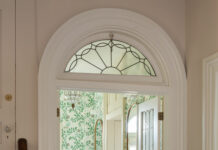Dickeyville began life in the 18th century as a settlement surrounding a grist mill. Today, it’s a quiet collection of homes set in what feels like an English country garden.
After driving through the gritty, western edge of Baltimore City, entering the historic mill community of Dickeyville feels like coming upon a place out of time. Many longtime Baltimoreans have never been here— it’s hard to find until you know the way. But once you’re here, it’s difficult to leave.
Dickeyville was first settled in the 1760s, when a grist mill was built to take advantage of the water power offered by the Gywnns Falls. While nothing remains of that 1760s mill or the settlement that grew up around it, some structures do remain from the village’s succession of 19th-century mill settlements. By the early 20th century, “the mills declined and by the Great Depression, the village had acquired a new name, ‘Hillsdale,’ which had come to be another word for ‘slum,’” says Dickeyville resident and historian and retired University of Baltimore professor Jane Keller. Keller credits the 1934 purchase of Hillsdale by the Roland Park Co. for the transformation of a village that is now listed on the National Register of Historic Places.
When the same company that built Roland Park, Guilford, Homeland, Sudbrook Park, Original Northwood and Dundalk took possession of 81 buildings on 60 acres for the princely sum of $42,000, the company tore down many large, dilapidated mill buildings, then sold a portion of the mostly 19th-century mill houses to individual buyers for renovation. The company then set about building new brick and clapboard houses with slate roofs among the old mill houses. As with its other communities “the Roland Park Co. oversaw the whole in order to create a cohesive neighborhood,” says Keller. Of the 130 houses in the village today, half are from the 19th century and half are from the 20th century, with the two oldest homes dating back to 1808-1810.
Many elements found in Roland Park and the other planned neighborhoods can be seen on a smaller scale in Dickeyville: preservation of established shade trees above common greens and greenways that connect residents to nature and each other; a curved hierarchy of byways— streets, sidewalks, lanes and footpaths— that follow the varied, natural topography and foster a sense of community; strict architectural covenants that preserve the historic buildings; and aesthetic integrity of architecturally significant houses.
Almost 75 years later, both the architecture and the connection to nature remain strong, as does neighborhood participation in everything from a 1980s community purchase of a hilly woodland parcel for environmental protection to a Fourth of July extravaganza complete with parade, picnic, dinner-dance and fireworks. Residents easily get to know one another by strolling the winding streets and the paths in the city-owned parkland, including a dedicated walking path by the rushing Gwynns Falls.
Style photographer Celia Pearson and writer Kathy Hudson spent several enchanted days wandering the village, talking with residents about their private gardens, admiring the pastoral setting and public green spaces, and feeling as if they had traveled across the Atlantic, when they had only driven across the city.



